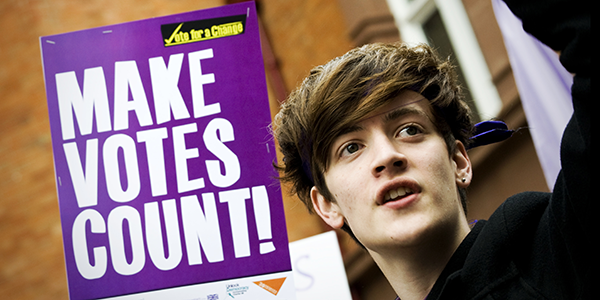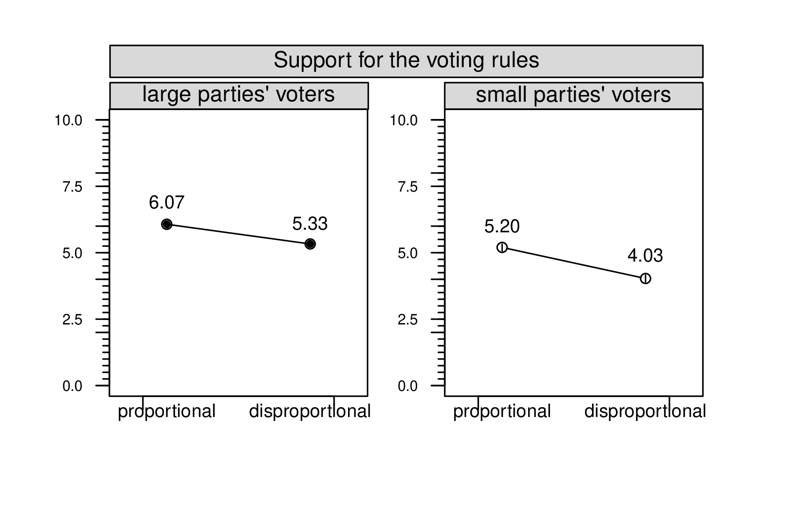Voters dislike disproportionality in electoral systems – even when it benefits the party they support
Taking advantage of a uniquely designed survey experiment, Carolina Plescia, André Blais and John Högström investigate the effect of proportionality on voter support for voting rules in four countries, namely Austria, the UK, Ireland and Sweden. They find that voters for both small and large parties dislike disproportionality in electoral systems, with little cross-country variation.

Protest for proportional representation, UK. Picture: Jason / (CC BY-NC 2.0) licence
In 2015, the UK Independence Party (UKIP) received 12.6% of the votes at the general election but won only a single seat. This sparked a discussion in the media about the fairness of the election rules used to elect the House of Commons and led to the resignation of the then-UKIP party leader, Nigel Farage, who had failed to win a seat. Discussions about how votes are translated into seats are common in the aftermath of elections in many countries. But are those who ‘complain’ about the unfairness of electoral rules simply ‘sore losers’ blaming the system for their loss? More generally, the question is: does the type of votes-to-seats conversion – more versus less proportional – matter? Do winners and losers react similarly to a possible ‘unfair’ distribution of seats? Are people willing to support an unfair system simply because their party is advantaged? These are important research questions because we know it is crucial for the stability of democratic systems that especially those who supported the losing side in an election are willing to recognise the legitimacy of the process and comply with election outcomes.
To examine whether the proportionality of the voting rules matter for both groups of large and small parties’ voters, we made use of a randomised survey experiment for a recent paper published in European Journal of Political Research. The experimental set up deals with a problem that would plague any observational study. Commonly disproportionality advantages larger parties and disadvantages smaller ones, so it becomes almost impossible using non-experimental data to assess whether voters’ reaction to the electoral outcome is due to the performance of the party they support or the voting rules. By using random assignment, our experiments can directly manipulate party performance (high or low) and the proportionality of the electoral outcome (high or low), so that alternative explanations can be ruled out. In addition, the same study was conducted in four countries, which differ substantially in terms of electoral rules. Three of these countries use a proportional system – Austria, Ireland and Sweden – while the UK uses a majoritarian rule. These features afford us an opportunity to test whether our results hold across systems and to check whether there is a status quo bias leading people to prefer election procedures that do not deviate from what they are used to.
In the survey, respondents were asked: ‘On a scale of 0–10, where 0 means “not at all satisfied” and 10 means “very satisfied”, how satisfied are you with these voting rules that you have just used for elections in [COUNTRY of STUDY]?’. Figure 1 shows the estimated average response conditional on whether the respondents’ party performance is low or high and whether the conversion of votes into seats is proportional or disproportional.
When it comes to party performance, between-group differences are significant, though not very large: high party performance increases support for the voting rules among that party’s supporters, and this is true in both the proportional and disproportional scenarios. Figure 1, however, also shows significant within-group differences. Namely, disproportionality decreases support for the voting rule so that both groups of voters are significantly less satisfied under disproportional outcomes. The results are illuminating especially for voters who support large parties: even if the conversion of votes into seats advantages large parties in the disproportional scenario, disproportionality still exerts a negative effect on support among this group of voters. Not only within-groups differences but also within-subject differences are significant. Table 1 shows that while there is no significant difference in support for the voting rule if a respondent is in the same condition in both elections (either proportional or disproportional), support declines if a respondent moves from proportional to disproportional voting rules (and vice versa).
Figure 1: Election outcome and voter support for the voting rules

Note: For more information, see the authors’ accompanying paper in the European Journal of Political Research.
Table 1: Within-subject differences in support for the voting rules

Note: For more information, see the authors’ accompanying paper in the European Journal of Political Research.
In terms of satisfaction with the conversion of votes into seats, even if large parties are ‘unfairly’ advantaged by the disproportional system in terms of seats, supporters of these parties still prefer the fairer (more proportional) conversion. We also find that the difference between being a small party supporter in a disproportional versus proportional system is negative and significant – that is, small parties’ supporters do not appreciate the disproportional conversion of votes into seats. The use of additional dependent variables that focus specifically on satisfaction with the election result and the conversion of votes into seats shows that disproportionality negatively affects satisfaction with the voting rule among small parties’ voters because it is unfair. Overall this suggests that disproportional rules make voters less satisfied: large parties’ voters, especially, are not simply ‘delighted voters’ that disregard how votes have been converted into seats. They want a fair system and they do not like a disproportional system, even when disproportionality advantages their party.
Though conclusions about system-specific findings should be treated with caution, given that there are only four countries in our study, we also tested whether concern about proportionality is lower in countries where national elections are more disproportional. Namely, we would expect that respondents in Austria and Sweden should react more negatively to disproportionality than respondents in Ireland and especially in the UK, who are used to disproportional results. Austrians and Swedes should react more negatively to the unfair outcomes because they deviate from the ‘fair’ votes-to-seats distribution they are used to. However, the results indicate that proportionality is ‘noted’ even more in a country not used to proportional rules, a result that does not square well with a status quo bias argument. In sum, we find little status quo bias, at least in the four countries included in our study.
Electoral systems should be judged using many more criteria than simply looking at how proportional the electoral outcome is; however, there is one aspect of electoral systems that is very visible to the public and as such often debated in times of proposed electoral reforms, namely the proportionality in the conversion of votes into seats. Our findings provide strong support for the idea that citizens do care about how votes are converted into seats, with disproportionality decreasing support for the voting rule among both large and small parties’ voters.
This article gives the views of the authors, and not the position of Democratic Audit. For more on this research, see the authors’ recent article, “Do people want a ‘fairer’ electoral system? An experimental study in four countries”, published in the European Journal of Political Research.
About the authors

Carolina Plescia is a postdoctoral researcher at the Department of Government at University of Vienna and member of the Austrian National Election Study.

André Blais is Professor in the Department of Political Science and holds a Research Chair in Electoral Studies at the University of Montreal.

John Högström is Associate Professor in Political Science, Department of Social Sciences, Mid Sweden University.





 Democratic Audit's core funding is provided by the Joseph Rowntree Charitable Trust. Additional funding is provided by the London School of Economics.
Democratic Audit's core funding is provided by the Joseph Rowntree Charitable Trust. Additional funding is provided by the London School of Economics.